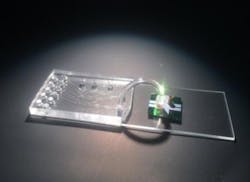Collaboration developing optofluidic-based test that screens for Zika
A team of researchers at the Texas Biomedical Research Institute (Texas Biomed; San Antonio, TX) is working on a new way to detect the mosquito-borneZika virusthat will help guide clinicians in their treatment of patients with the disease. The test uses optofluidic chips developed by researchers at the University of California at Santa Cruz, Brigham Young University (Provo, UT), and the University of California at Berkeley to screen bodily fluids (blood, urine, and semen) for the presence of the virus. This new approach will also help pinpoint the stage of the disease.
"What this technology will do is tell us, first of all, if you've already been infected. If you have antibodies, you wouldn't be at risk for a new infection. It will also tell us where you are in your infection," explains Jean Patterson, Ph.D., professor and chair of the BSL-4 Task Force | Host Pathogen Interaction lab at Texas Biomed.
Knowing the stage of the disease caused by Zika virus is critical, since many antivirals only work early in infections and are not very effective later in the course of the disease. This particular diagnostic test would tell clinicians if the patient is still in the RNA replicating stage (a sign of recent infection) or if the patient has started to produce viral particles (an indication the disease has progressed).
Texas Biomed provides knowledge about the Zika virus and viral material that the researchers at UC Santa Cruz can test. Also, the scientists are using marmosets from the Southwest National Primate Research Center (also in San Antonio) to provide blood, urine, and semen samples for testing. These are the kinds of samples clinicians would use for their human patients.
The optofluidic technology would help clinicians tailor therapies. (Photo credit: Josh Parks)
Electrical engineering Professor Holger Schmidt, Ph.D., of UC Santa Cruz describes the new technology as "a lab on a chip." Optofluidics uses a combination of two technologies. Microfluidics is a process that takes small biological samples for detection purposes like medical and chemical analysis. Then, integrated optics uses optical waveguides, lasers, and other optical elements on a chip. Together, these technologies can detect molecules without the need for amplification that other tests require.
The same test is being developed for another pathogen that Texas Biomed researches: Ebola virus. Schmidt says this less complex biological assay to detect infection would be helpful for people in remote areas like parts of Africa.

